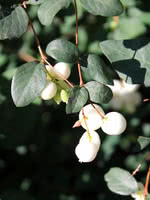Mon-Fri 9am - 5pm Mountain time
Western Snowberry vs Dappled Willow
Symphoricarpos occidentalis
Salix integra Hakuro-Nishiki
NOT AVAILABLE THIS SEASON - MIGHT RETURN
NOT AVAILABLE THIS SEASON - MIGHT RETURN
Like the Common Snowberry, the Western Snowberry is a small shrub with pink flowers useful for feeding livestock and preventing erosion. Unlike the common species, however, the Western Snowberry is much more suited to wet conditions, capable of persevering through poor soil drainage and occasional flooding.
After the Snowberry's flowers have bloomed, it produces berries which often last on the plant through winter. These berries are toxic to humans, but livestock and local wildlife love them! Those hoping to attract wildlife to their property can plant Snowberry and expect to see animals foraging on it much later in the year than other plants.
Dappled Willow is a small, cold hardy shrub with unusual beauty. Its leaves are pink in spring, maturing into variegated shades of pink, white and green. After losing their leaves in autumn, the stems maintain a rich red color throughout the winter. For a splash of color, try Dappled Willow on its own or as a hedge.
Western Snowberry Quick Facts
Dappled Willow Quick Facts
Toxicity: berries are toxic to humans

